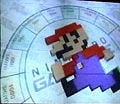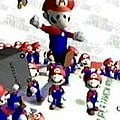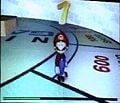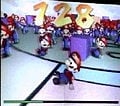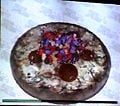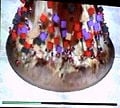Super Mario 128: Difference between revisions
mNo edit summary Tag: Mobile edit |
m (Text replacement - "<references/> {{" to "<references/> {{") |
||
| Line 62: | Line 62: | ||
==References== | ==References== | ||
<references/> | <references/> | ||
{{UnreleasedMedia}} | {{UnreleasedMedia}} | ||
{{GC}} | {{GC}} | ||
Revision as of 15:45, March 23, 2022
- This article is about the tech demo. For the event match from Super Smash Bros. Melee, see Super Smash Bros. Melee § Event match.
- “What happened to Super Mario 128? Most of you already played it…”
- —Shigeru Miyamoto
Super Mario 128 is the name of a series of projects by Nintendo to create a sequel to Super Mario 64, much like the canceled game Super Mario 64 2. While initially named in January 1997,[1] it was first shown as a tech demo at Spaceworld 2000, the project experimented with new technology and ideas to incorporate into later games. A demo of the project was released by Nintendo. The demo featured 128 Marios onscreen at once. Other features of the demo included the use of "rapid generation," later used in Pikmin,[2] and "sphere walking," later used in The Legend of Zelda: Twilight Princess[citation needed] and Super Mario Galaxy.[3] Super Mario 128 has been confirmed to be unrelated to Super Mario Sunshine.[4]
During his keynote speech at the Game Developers Conference 2007, Shigeru Miyamoto revealed what eventually happened to Super Mario 128. "What happened to Mario 128?" said Miyamoto at the end of his keynote. "Most of you already played it..." The screen then transitioned from Mario 128 to Pikmin.
Secretive true sequel to Super Mario 64
Aside from the tech demo shown off, another Super Mario 128 was secretly in development, with Shigeru Miyamoto being the director. This would have been the final game that he directed, had it been completed. He stated that the reason he wanted to make a sequel, which would have taken at least one and a half years according to an interview at the 1996 Electronic Entertainment Expo, was that Super Mario 64 used only 60% of the capacity of the Nintendo 64.
The game was originally planned to release on the Nintendo 64DD peripheral for the system, but it was shifted to the GameCube following the development being delayed after the release of The Legend of Zelda: Ocarina of Time, which had been delayed to a 1998 release, as well as the 64DD's discontinuation due to its commercial failure. The game would have featured a potential co-op single-player mode featuring Mario and Luigi, as well as four-player split-screen multiplayer akin to Mario Kart 64 with rumors stating that Peach and Toad were meant to be playable in multiplayer, something that would not happen until Super Mario 3D World in 2013, as well as rumors from the European magazine, Nintendo Official Magazine (rebranded as Official Nintendo Magazine in later years), that stated that Yoshi would have been rideable.
In 1999, Miyamoto began to express disapproval over the Mario series becoming too child-friendly, believing that players would grow out of those kinds of games when they reached middle school. He wanted to stop Mario from using his peace sign gesture and have him stop smiling and laughing for no good reason, due to those qualities factoring in what he felt was not right. He also wanted the game to have more mature graphics and a more grown-up version of the title character, even going so far as having an interview in an issue of the Japanese magazine, Playboy Weekly, promising that the game would have a fresh new experience.
Fans expected the game to appear at E3's showings in 2003 and 2004, but the game was not shown at all due to Miyamoto's wanting to keep the new ideas for the game from being copied by other companies, even saying at E3 2005 that the game may not be released on GameCube after all. At the Game Developers Conference 2007, where he revealed that the tech demo shown off at Space World 2000 became Pikmin in terms of gameplay, he said that it also became Super Mario Galaxy in terms of stage design. Reporters stopped asking him about the game.
This interpretation of Super Mario 128 seemed to influence other games such as Super Mario 64 DS (Luigi's playability), The Legend of Zelda: Majora's Mask, and Pikmin 2 (single-player cooperative gameplay), Super Mario Sunshine (the ability to ride Yoshi), Super Mario 3D World (four-player cooperative multiplayer), and both Super Mario Sunshine and Super Mario Galaxy (the removal of Mario's peace sign gesture prior to its return in Super Mario Odyssey).
References in other games
- A mission in Super Smash Bros. Melee is titled "Super Mario 128," where the player must defeat 128 tiny Marios.
- The idea to have 128 Marios at once in the demo may have inspired the idea of Luiginoids in the 3DS game Mario & Luigi: Dream Team, where the player uses clones of Luigi to navigate through various areas.
Gallery
External links
References
- ^ Nintendo Power (January 1997). "Miyamoto Interviews". Miyamoto Shrine. Retrieved September 19, 2018.
- ^ Martin, Matt (March 9, 2007). "GDC: Shigeru Miyamoto's Keynote Speech". GamesIndustry.biz. Retrieved September 19, 2018.
- ^ IGN (August 21, 2006). "Miyamoto Opens the Vault". IGN. Retrieved September 19, 2018.
- ^ Davies, Paul (May 16, 2003). "E3 2003: Miyamoto: the interview". Computer and Video Games. Retrieved September 19, 2018.
